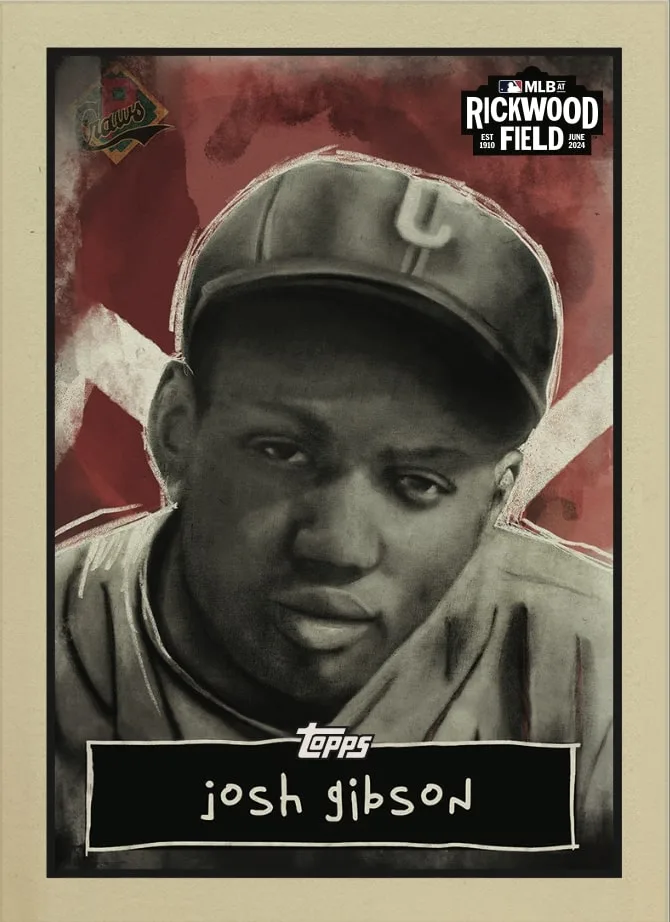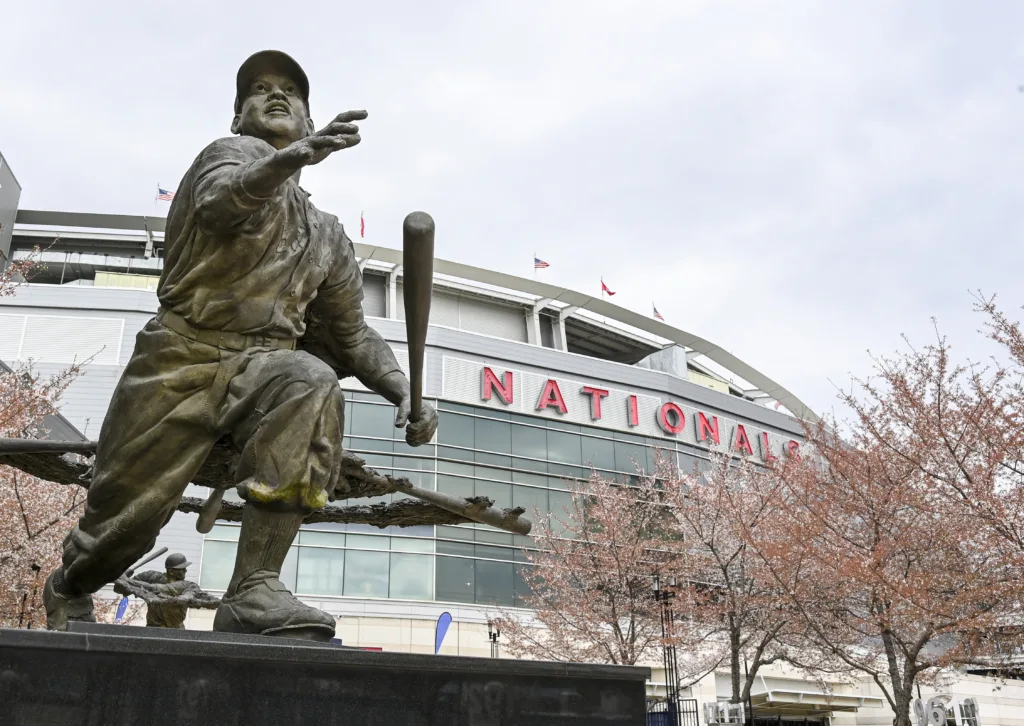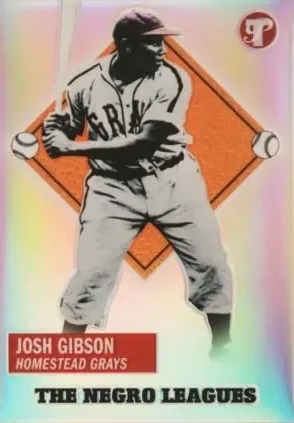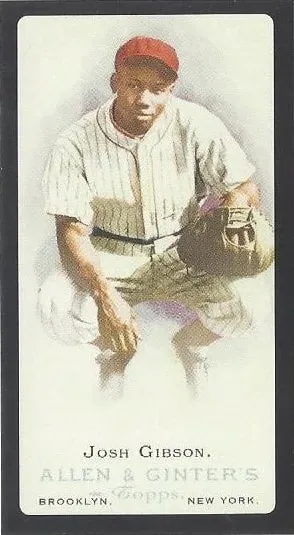
The Incomparable Josh Gibson
Josh Gibson’s incredible career spanned 1930-1946, but no mainstream cards from that era featured his image. There is one known 1931 postcard with Gibson’s image produced by Harrison Studios and one simple-looking “Joshua Gibson” card included in the 1950-51 Toleteros set—both are extremely rare.

1950-51 Toleteros Joshua Gibson
As word quickly got around, Gibson’s reputation was on the rise among serious baseball fans long before he retired. He had been called (quite unjustly, considering that he was not allowed to participate in the MLB) the “black Babe Ruth” since his playing days, and even then, according to biographer William Brashler, some fans, who saw both men play, pointedly insisted on calling Ruth the “white Josh Gibson.” In 1972, Gibson became the second Negro Leagues player inducted into the National Baseball Hall of Fame.
In our century, Gibson’s life and career is no longer understood in reference to any white players. Now that the MLB has combined Negro Leagues stats in Cooperstown, Josh Gibson stands alone as the undisputed batting leader in MLB history. As demand for cards honoring the greatest players of the 20th century continues, card companies have issued several retrospective cards highlighting his career, and collectors have taken notice.
Further cementing Gibson’s mythic stature in MLB history—as well as the Negro Leagues more broadly—the St. Louis Cardinals and San Francisco Giants will be playing a regular season game at Rickwood Field in Birmingham, Alabama. Home to the Negro League’s Birmingham Black Barons, Rickwood Field is a hallowed and historic site in baseball and American culture. Be sure and catch the game on 6/20.
Josh Gibson’s Historic Legacy
Because he was excluded from the MLB, Gibson’s prowess and accomplishments are at least partially destined to remain legendary. We know his career best by studying the reports told by those who played with and against him, and by the anecdotes that represent his seemingly unlimited ability. The highest praise came from players like Buck O’Neil, Satchel Paige, and Monte Irvin, who all struggled to articulate just how good Gibson was. Asked to assess Gibson’s talent, Hall of Fame catcher Roy Campanella simply said, “Everything I could do, Josh could do better.”
Off the field, Gibson’s life was marked by difficulty. His wife had died during childbirth in 1930, just a year after they had married. Tragically, in 1947, just a few months before Jackie Robinson’s debut in the Majors, Gibson passed away at only 35 due to complications from a brain tumor.

Statue of Josh Gibson outside of Nationals Park in Washington, D.C. (Photo by Jonathan Newton /The Washington Post via Getty Images)
Today, Josh Gibson’s star only continues to rise. Now more than ever, baseball fans understand that Gibson was one of the best—if not the best—ever to play the game. In 2009, a statue of Gibson was unveiled at Nationals Park to honor his remarkable career. Even the U.S. Postal Service has honored Gibson with a 33-cent commemorative stamp. And, of course, as of May 29, 2024, Josh Gibson has now been officially recognized as Major League Baseball’s all-time batting leader, setting the pace for career batting average (.372), slugging percentage (.718), and OPS (1.177).
The staggering statistics that have been preserved offer a tantalizing glimpse at what might have been. Through the injustice of segregation and a difficult personal life, Gibson shined. Fans can only wonder how he might have fared against Dizzy Dean, Lefty Gomez, or Carl Hubbell. Nevertheless, the myths and legends describing Josh Gibson’s career amply testify to his remarkable talent. The recognition and accolades he deserved came too late, but it is here to stay, and his incomparable talent will never be forgotten and can never be diminished.
A Survey of Josh Gibson Cards
In 2001, commemorating its own 50th year, Topps produced a Negro Leagues “What Could Have Been” insert set in Series 2 that included a striking Josh Gibson card. The card featured no statistics on the back but did give a short write-up of the legendary aspects of Gibson’s reputation. Then, in 2005, the Topps Pristine Legends Refractor set honored Gibson again.

2005 Topps Pristine Legends-Refractor #135 Josh Gibson
In 2006, Allen & Ginter issued a mini Josh Gibson card with a sharp black border (#288). The Allen & Ginter card, like the 2005 Topps card, makes mention of reports that Gibson totaled close to 800 career HR. Because he played in numerous leagues before the modern era, definitive statistics are difficult to find and contested. In late 2020—and fully incorporated in 2024—Major League Baseball decided to formally accept Negro League statistics.

2006 Allen & Ginter Mini Black Border #288 Josh Gibson
Still, the records are incomplete. In a 14-year career with the Pittsburgh Crawfords and the Homestead Grays, Gibson played approximately 50 games per season. Adjusting his totals to a hypothetical 162-game average season, Gibson’s statistics are jaw-dropping: with a .373 average, Gibson would have posted 45 HR and 197 RBI in a typical full MLB season. In 1943, playing in 69 games with the Grays, Gibson’s season batting average is listed at .466.
The Latest in Josh Gibson Cards and Relics
Gibson cards have continued to draw collectors over the past decade. The slugger was the subject of at least three different artistic renditions in another anniversary set, the 2021 Topps Project70® series. A few relic cards have also been produced, including two cut signature cards and a 2005 Bowman Sterling Stadium Seat card, which features a small relic from Forbes Field’s stadium seating.
A selection of Topps Project70® Josh Gibson cards
The 2022 Topps Chrome Update Diamond Greats series included a Die Cut Josh Gibson card (#73), which, on its reverse side, commemorates Gibson’s July 24, 1938 538-foot homerun. A 2023 Bowman Chrome 1-of-1 superfractor Gibson card featuring Gibson with the Crawfords is notable, along with a Topps Stadium Club Gibson card (#9) from the same year, for being the first to include his career statistics on the back.
This year, the Topps Rickwood Field collection will include Josh Gibson and five other legendary Negro Leagues players in a six-card series created by artist and former MLBer Micah Johnson. In addition to celebrating Gibson and other luminaries of the Negro Leagues, tune into Fox on 6/20 for the MLB at Rickwood Field, the first-ever MLB game played at a historic Negro Leagues field.

2024 Topps MLB at Rickwood Negro League Collection #RW-2 Josh Gibson




